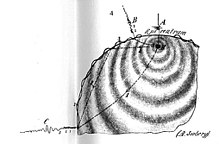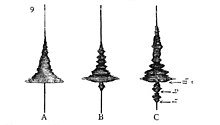August Heinrich Sieberg
August Heinrich Sieberg | |
|---|---|
| Born | 23 December 1875 University of Athens) |
| Scientific career | |
| Fields | geophysics, seismology |
| Theses |
|
August Heinrich Sieberg (born 23 December 1875 in
Sieberg studied natural sciences at
After the First World War Strasbourg became French and Sieberg moved in 1919 together with the director of the Strasbourg main station,
In 1925 Siebert was awarded the Golden Ring of Honour[
Scientific research
As a
 |
 |
| Illustrations by A. Sieberg for the Earth quake (Zemětřesení) article in Otto's Encyclopedia (Ottův slovník naučný, vol. 27, p. 565–571, Prague, 1908). |
In 1912 Sieberg introduced the twelve-degree
In 1927 he developed the Sieberg Scale, a six-degree scale for assessing the strength of tsunamis on the basis of their effects on humans, buildings and nature, which was adapted in 1962 by Nicholas Ambraseys in the form of the Sieberg-Ambraseys Tsunami Intensity Scale to the usual twelve-degree earthquake scales. In 1939 Sieberg published the first earthquake catalogue of Germany and neighbouring areas.
References
- ^ a b c Fritz Pfaffl (2013). "August H. Sieberg (1875-1945), der Begründer der modernen Makroseismik und Erdbebenkunde an der Universität Jena (Deutschland)" (PDF). Bericht Naturf. Ges. Bamberg. LXXX: 125–145.
- ^ a b c Gerhard Krumbach (1949). "August Sieberg zum Gedächtnis". Seismische Arbeiten – Veröffentlichungen des Zentralsinstituts für Erdbebenforschung in Jena. 51: 6–9.
- Academy of Sciences Leopoldina
- ^ a b Ivanka Paskaleva, Michel Cara, Giuliano F. Panza: A. Sieberg, Experience and Lessons on the Origin, Prevention and Elimination of Earthquake Damages.[permanent dead link] Electronic Newsletter of the IASPEI Commission on Earthquake Hazard, Risk and Strong Ground Motion (SHR), Vol. 8, No. 2, 15 Feb 2007
![]() Media related to August Heinrich Sieberg (geophysicist) at Wikimedia Commons
Media related to August Heinrich Sieberg (geophysicist) at Wikimedia Commons
